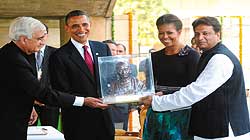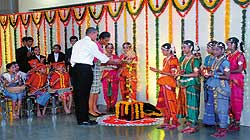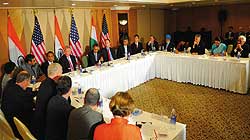|
American President Barack Obama is a man of many parts, one of which has trained him in the art of playing to the galleries. He is also a leader that loves his oration, a man who almost always knows what his audience wishes to hear. In India too, after keeping an entire nation on tenterhooks, the political establishment puzzled, several opposition leaders unhappy, and the media somewhat belligerent during the first leg of his visit in Mumbai, he said what the entire nation was waiting to hear, dropping the P word inside New Delhi’s Parliament, and making a direct reference to the importance of Pakistan dismantling terror infrastructure in that country.
The speech inside Parliament, including the brief but remarkably significant reference to Pakistan, won him more brownie points and friends in India than everything he had said and done until then. By instinctively playing to the gallery, he said what an entire nation wanted to hear. His earlier engagements had included among others an address to some of the families of those who lost their lives during 26/11, a visit to Mani Bhavan, an interaction with a bright set of students at Mumbai’s Saint Xavier’s College, the announcement of the signing of 10 billion dollars worth of business deals, and a joint press conference with Prime Minister Manmohan Singh. Not until midway into his speech in Parliament did Obama pull out the P-card, carefully mentioning no more than a sentence. But it was enough to swing the mood dramatically. By the time he stepped on to Air Force One and flew away to Indonesia, his next stop, India was hailing the unqualified success of the Obama visit to India.
 |
 |
| Delivering a riveting speech in Parliament |
Getting a slice of Gandhi at Mumbai’s Mani Bhawan |
And the mention of the P-word was way too timely. Until the point that he directly named Pakistan (he had earlier stayed away from any reference to that country), all that he had said, or done had been unable to create the kind of impact his speech in Parliament was to. A slew of hawkish panellists inside TV channel studios time and again declared how India was not quite at ease with America’s Pakistan policy—one that declares that terror outfits abound in that country, and another that keeps arming the country with war equipment and providing it with billions of dollars in aid (on paper to fight terror), much to the harm of India’s own security interests.
Not that his tour was in any danger of receiving less attention than it did, but the mood, until then, was never too ebullient. Even the fact that India was going to create a very large pool of jobs in the United States—the numbers going around stood at well over 50,000 (“we should be proud of this,” gushed BJP leader Yashwant Sinha at one point at a TV discussion)—was not being celebrated, until that time in Parliament. Industrialist Rahul Bajaj reflected the early wait-and-watch attitude when he acerbically mentioned to a TV channel that “the President of the United States tells us that there would be trade benefits, but really I want to know how I’ll get jobs here, how India would benefit from the visit?”
| HIGHLIGHTS
· In his speech in Parliament, mentions how Pakistan needs to dismantle terror infrastructure
· Indirectly criticizes India for not taking a more proactive role in the process of restoring democracy in Myanmar
· Mentions that America’s partnership with India will be the defining one of the 21st century
· Sets up a mechanism for more robust business exchanges between the two countries
· Demonstrates his love and enduring respect for Mahatma Gandhi by visiting Raj Ghat in Delhi and Mani Bhavan in Mumbai
· Interacts extensively with youth, recognizing the significance of India’s large, young population |
In Parliament, once he was done with the P-word, and done with praising India’s ancient heritage, and what it meant to the world in the past, and at present (“India is no longer rising,” he said, “it has already risen.”), its spirit of non-violence, the inspiration that came from Mahatma Gandhi, Swami Vivekananda, Rabindranath Tagore, Ambedkar, did India celebrate his visit. TV channels softened their stance, and the opposition, primarily the BJP looked a little red-faced for having lashed out at him a wee bit early into his tour through its spokesman (Rajiv Pratap Rudy).
 |
 |
| |
|
 |
 |
| |
|
 |
 |
| |
| (Clockwise from top left): Demonstrates his special fondness for Prime Minister Singh by putting an arm around his shoulders, receives a Gandhi souvenir in Delhi alongside wife and American First Lady Michelle Obama, interacts with dance students in Mumbai, fields questions from students assembled at Saint Xavier’s College in Mumbai, signing a book dedicated to the memory of the victims of 26/11, and addressing top business leaders |
Across the border, at least one Pakistani newspaper, Express Tribune, acknowledged that Obama’s message had hit home. In an article titled “Wake up and smell the failure”, it mentioned that the symbolism of the American President’s visit to India was bigger than the expansive trade deals, and kind words. “Our sole export seems to have become terror and while we beg for aid to cope with globalization... India unveils deals worth $ 10 billion designed to create 50,000 American jobs in an ailing economy. That’s right: India... sought to be the largest democracy in the world and they achieved it, and we sought to be the most dangerous country of the world, and we certainly achieved it.”
Business will go on, as usual. But it is that symbolism that made a difference. Like usual, Obama had worked out his gallery
well.
|